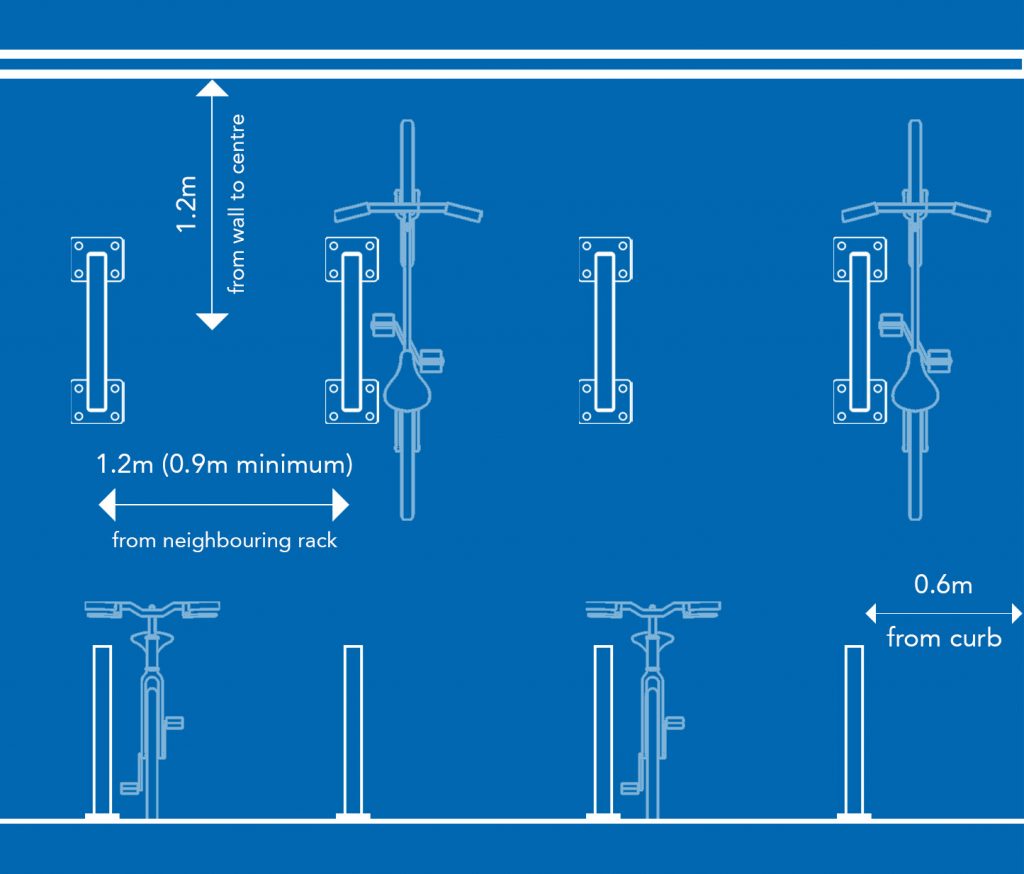Tal-Barrani
Tal-Barrani
Whilst understanding that the works have been labelled as ‘temporary’, it is UNACCEPTABLE that the temporary works take away the already limited existing bicycle connections within the area. If proper cycling infrastructure may not be added through these works, the bare minimum that Infrastructure Malta must retain in its proposals, are the existing connections between the localities which are in very close proximity.
CONCERN 1
The main connection affected by this proposal is that between Zejtun and Tarxien. An already difficult crossing has been rendered null with the conversion of the Triq Hal Tarxien (Figure 1), into one way traffic.
This junction design not only eliminates an existing cycling connection, but seems to create an unsafe/bottleneck issue. As illustrated in the proposal, cars coming from Triq San Anard will only turn into Triq Hal Tarxien, is if they want to continue on triq Hal Tarxien (otherwise, they will end up back on Triq Tal-Barrani). This means that cars will have to cross 2 busy lanes in a short distance of around 130m. An safer alternative would be to direct this traffic flow into one of the two lanes coming from the Zabbar side (Figure 2). This option will free up space to allow for segregated walking and bicycle lane on the side of the Bulebel industrial area and connected to the planned traffic lights.
This section of Triq Hal Tarxien does not have any existing pavements and the there is only one access gate on the side of the fields. Therefore, with two lanes instead of three, an easier exit may be planned for the field, whilst dedicating the maximum width for walking and bicycle lane on the industrial estate side.


CONCERN 2
During the meeting, IM stated that is does not recommend use of these heavy traffic roads by pedestrians. Yet, through the re design, cyclists are forced onto the main roads and connections between the close localities, have been eliminated or ignored
An ideal connection between Gudja and Tarxien would be a crossing as shown in Figure 3. This will keep pedestrians/cyclists safe and off the arterial roads, whist connecting directly to service roads on the opposite side. An alternative solution discussed during the meeting is that shown in Figure 4, whereby crossings will be added to allow access into Tarxien. However, as remarked, this is an unsafe location to cross from (yellow mark Figure 4&5) given that pedestrians and cyclists alike will be waiting along heavy moving traffic, meaning that a safe waiting area will need to be created.



A similar issue and poor crossing design is that shown in Figure 6/7. This exposes pedestrians and cyclists to heavy traffic without adequate safe infrastructure.


CONCERN 3
Has the existing full road width on Triq Tal-Barrani, been put to optimum use?
Tal-Barrani has undisputedly a very similar wall-to-wall width as Triq San Tumas in Hal Luqa (a recently upgraded road that incorporates a segregated path) for the same number of lanes. This makes it very feasible for Tal-Barrani to go through a a similar re-design, and have a segregated path that does not require widening, removing trees, or removing lanes. The segregated path would be running along Tal-Barrani like a separate road in its own right. Figure 8&9


We believe that the proposal has not been prepared holistically, but as a means of car traffic diversions, whilst changing quieter roads into heavy traffic roads. These works and redesign are an opportunity to offer better connections for alternative means of transport, hopefully alleviating our dependency on car usage over time. Through further discussions and better re-design, we believe we may achieve a better proposal that takes cognizance of pedestrians and cyclists alike. If IM pushes through with this proposal, this will force out any existing bicycle commuters from the area and work against a promised improved cycling networks across Malta.
CONCERN 4
Infrastructure Malta’s plan will cause the final blow to all blocked routes in the entire area below:
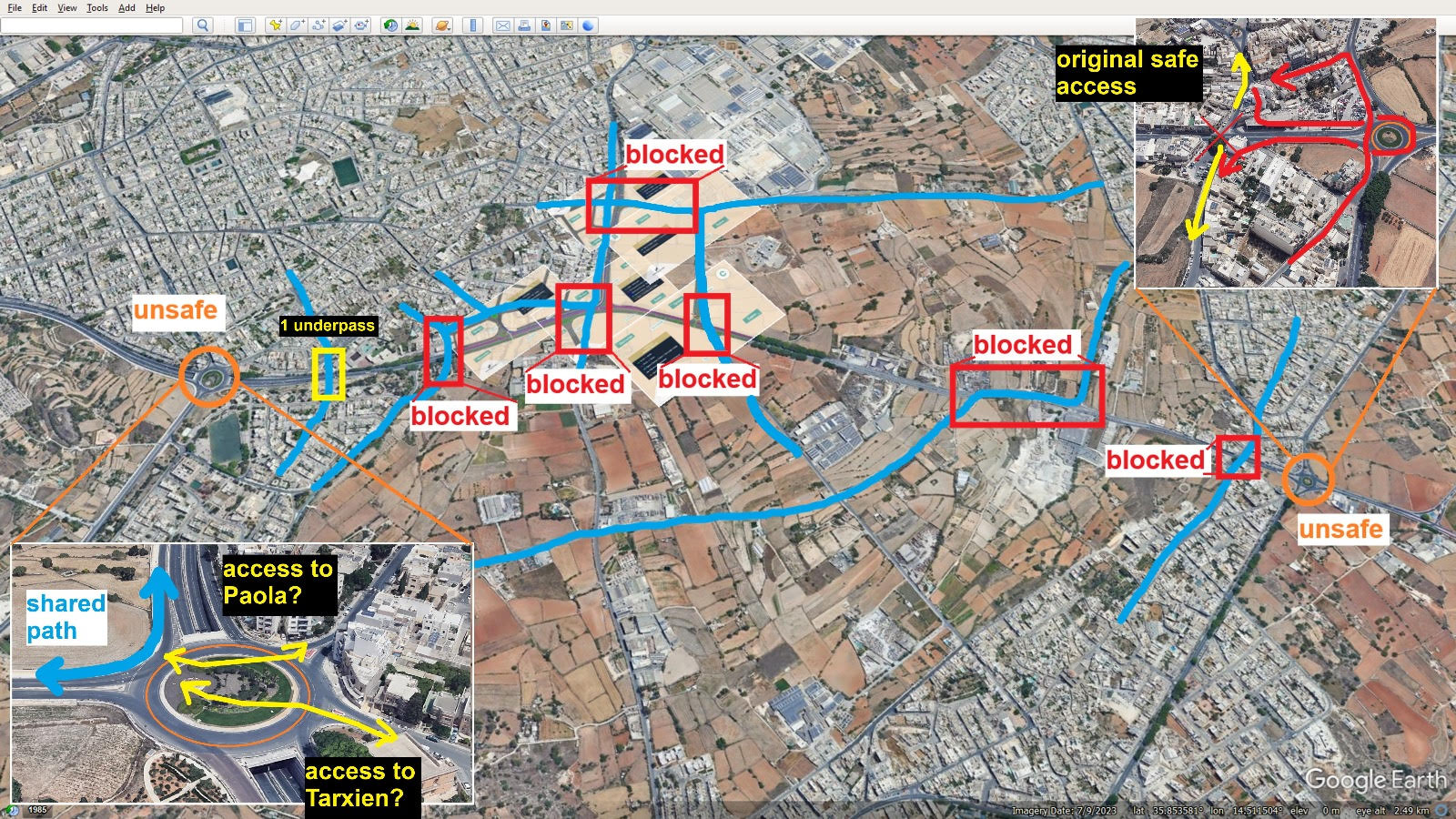
Our analysis was carried out following long processes and analysis, observations of historical maps and a deep understanding of connecting all origins and destinations seamlessly together.
It is simply about reconnecting the original road networks and keeping them separate from the modern-day realignments & new bypasses
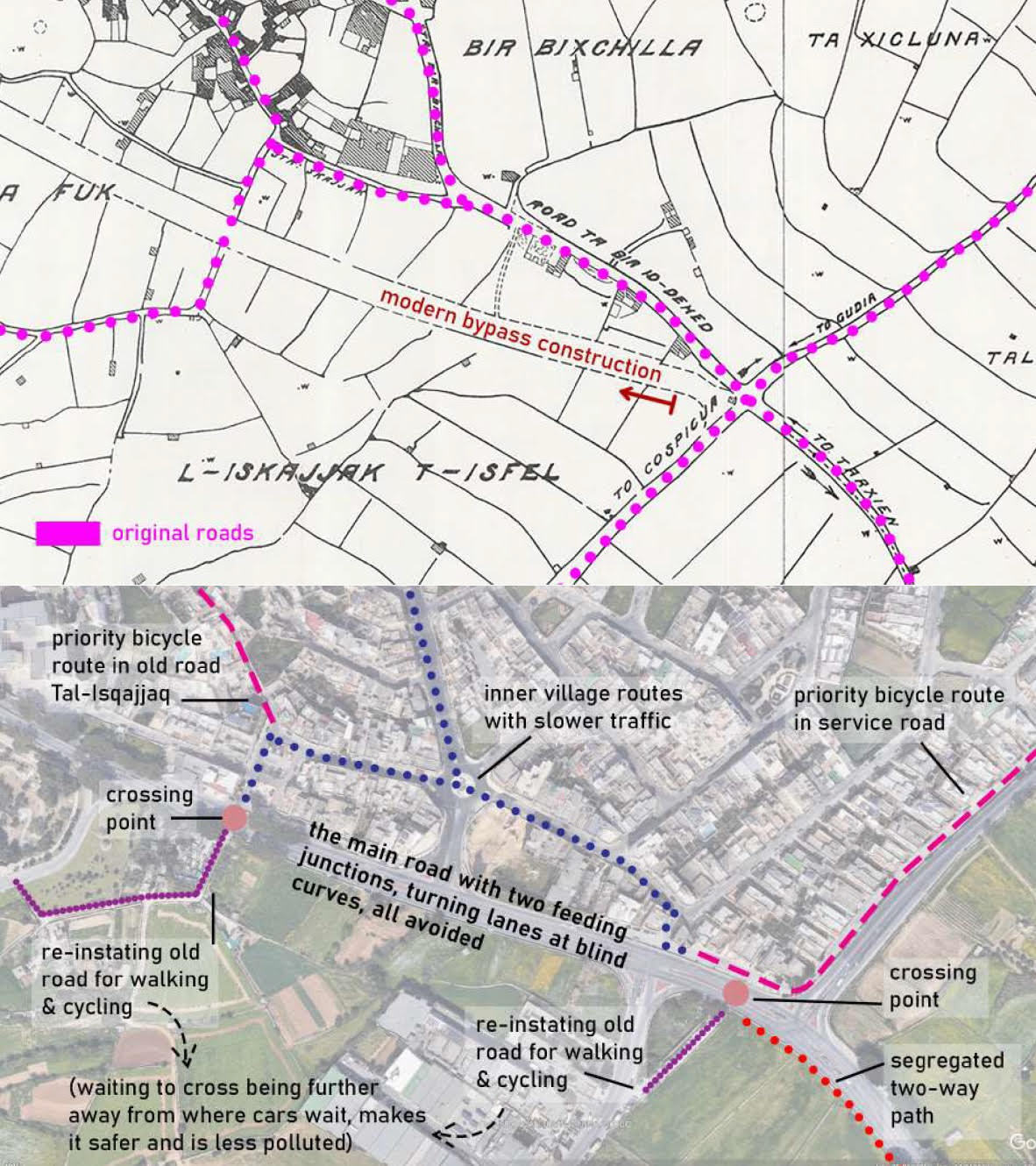
Tal-Barrani, San Anard, and its side connection off-shooting into Santa Luċija, are all earmarked and committed in the €35 million C-SAM bicycle network announced by the government. We do not see any hard infrastructure being introduced in this project.
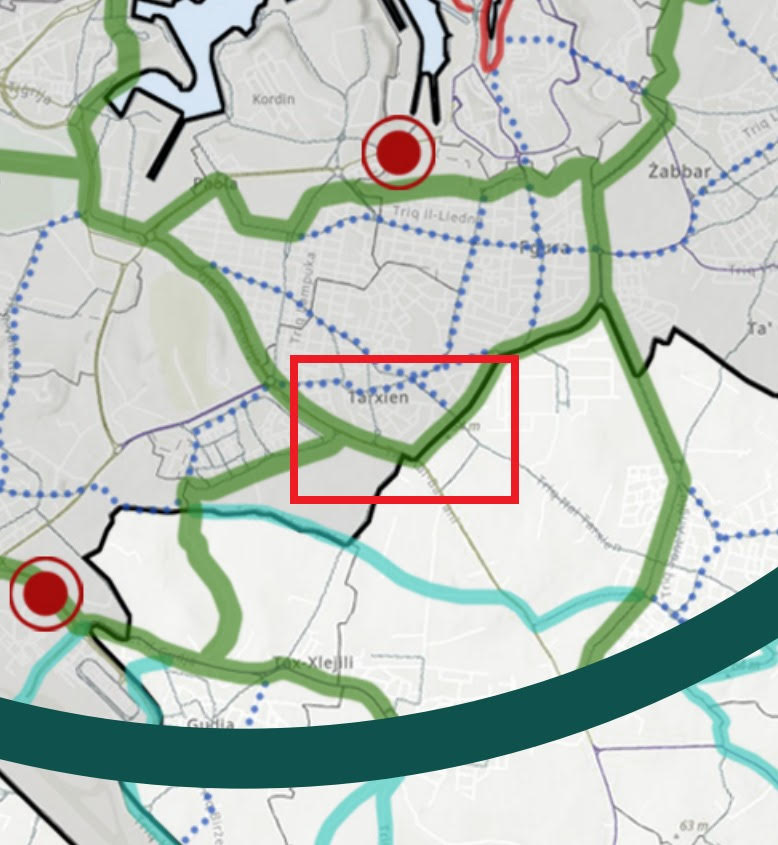
Bicycle Parking
Guidelines for Bicycle Racks
TLDR; bicycle racks are essential for sustainable mobility as they offer convenience and theft reduction (if the correct type is used). Oh, and you can get them for free (or at 50% the cost) with the Government grant.
1. Why do we need bicycle racks?
Cycling is one of the most sustainable and healthy forms of transport. Increasing the number of bicycle users can ease congestion, improve public health, enrich our environment and take pressure off public transport. One important aspect of commuting by bicycle, is bicycle parking and one way of encouraging cycling is to install adequate, convenient, secure and easily accessible bicycle racks at multiple points around a village or city. Bicycle parking is much more efficient than car parking as one car parking space can provide space for a minimum of 6 bicycles (assuming a relatively small car parking space of ~4.5m).
The lack of bicycle parking can seriously discourage bicycle use. Therefore, providing bicycle racks in/near residential areas, offices, parking lots, retail outlets, institutions and near lodging will indirectly promote cycling whilst facilitating the experience for all bicycle users. People are more likely to use a bicycle if they are confident that they will find convenient and secure parking at their destination.
1.1 How to lock a bicycle securely
We will first illustrate how to securely lock a bicycle as this is what inspires adequate, and secure bicycle racks. The best approach is to secure the bicycle frame, and ideally one wheel, to an immovable and secure object with a U-lock. As an extra level of protection, it’s recommended to secure both wheels using a cable that is secured to the U-lock. We therefore recommend bicycle users to buy (i) U-lock and (ii) a cable.
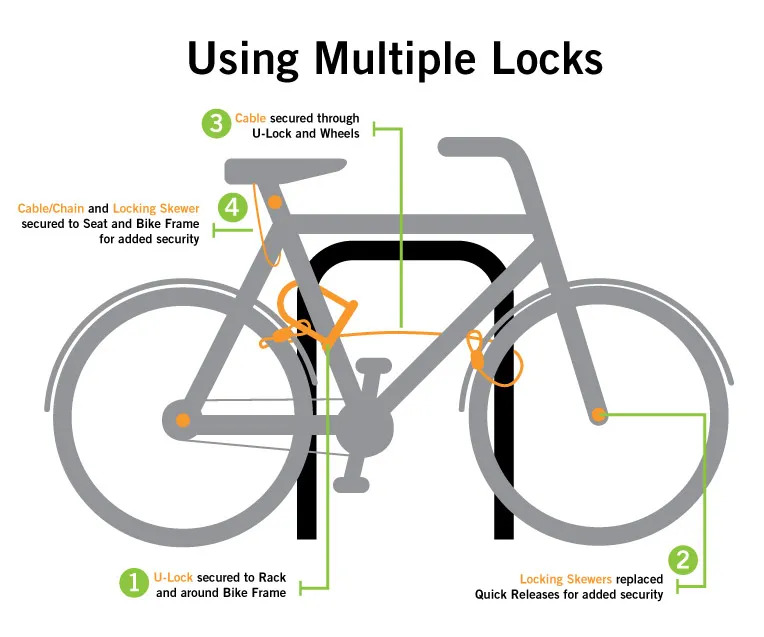
2. Bicycle Rack Design Guide
The previous section illustrated how a bicycle must be locked for it to be secure. However, the bicycle rack itself dictates how conveniently and securely one can lock their bicycle. Bicycle parking can be split in two main categories: (i) Short Term Parking and (ii) Long Term Parking. We will focus on short-term parking in this section. A bicycle rack must meet the following performance criteria* for it to be adequate and secure:
-
- Supports the bicycle upright (keeping both wheels on the ground)
- Allows locking of the frame and at least one wheel with a U-lock, and have at least two points of contact with the bicycle.
- Materials are durable and secure
- Use is intuitive and convenient
- Accommodates a variety of bicycles and attachments (there are multiple kinds of bicycles)
*obtained from Boston Bike Parking Guidelines and City of Cambridge Bicycle Parking Guide
2.1 The Recommended Design
The Sheffield bicycle rack (also known as Inverted U Rack) is a highly functional bicycle rack, and for this reason is preferred by bicycle users. It is our recommended standard for bicycle racks, however, the Post-and-Ring design illustrated below also meets the performance criteria set out above. Two bicycles can fit with every rack, and each rack is tall enough to lock the frame with the rack (unlike wheelbenders).

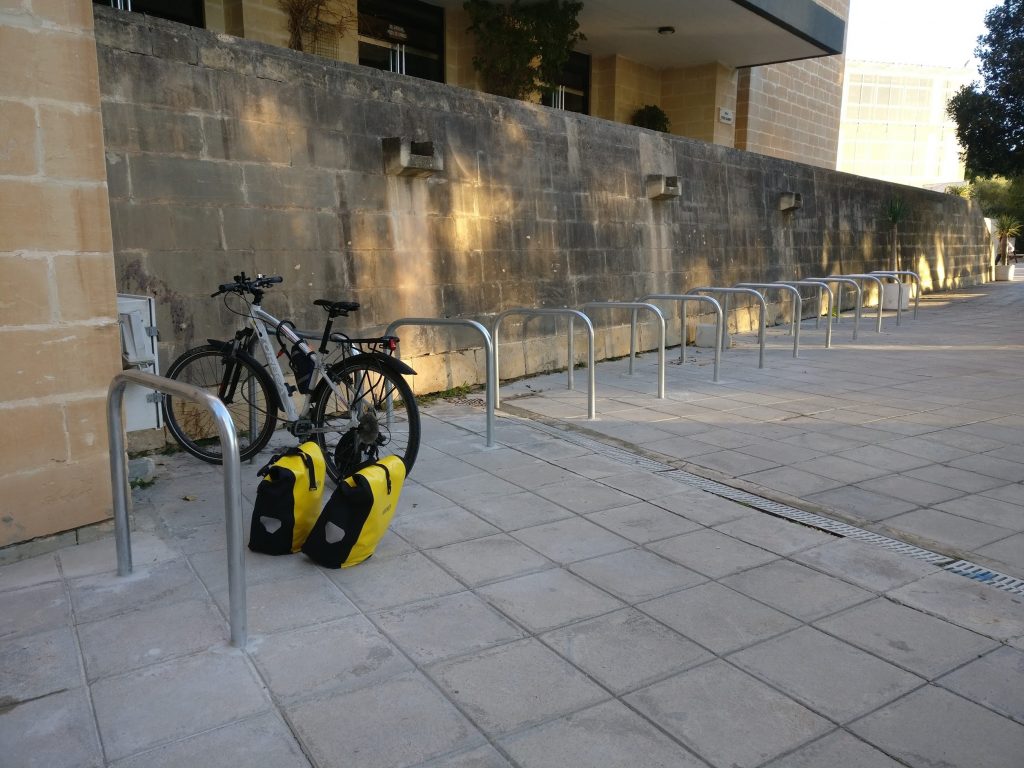
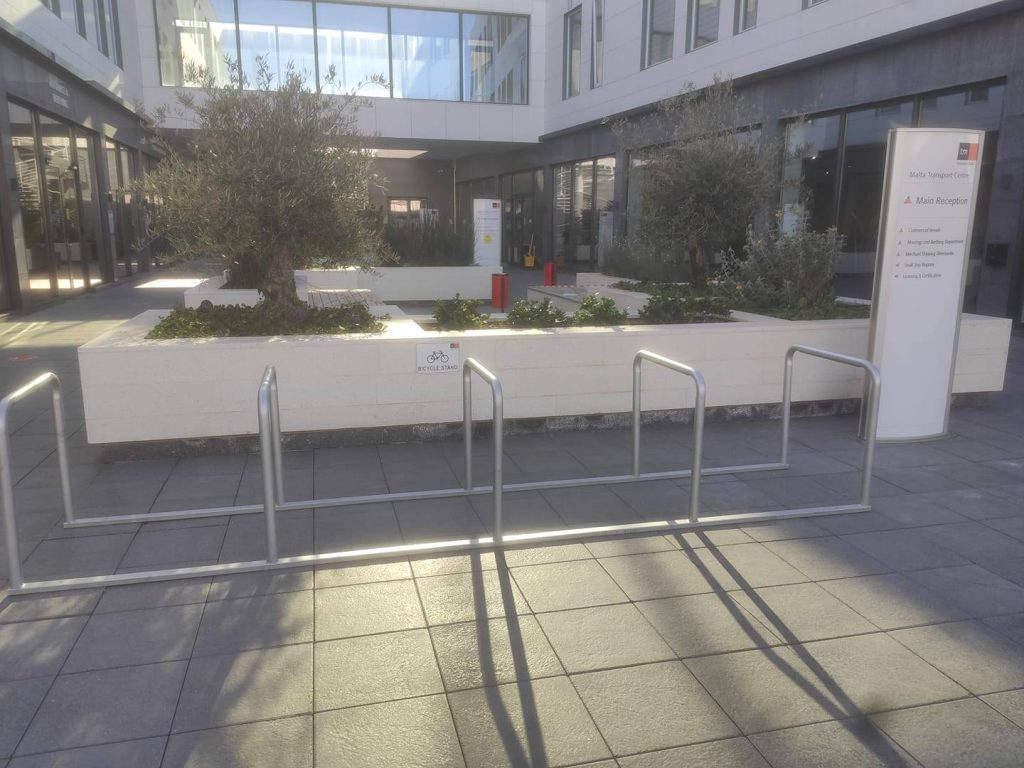
For added safety, these bicycle racks can be mounted in-ground to prevent theft. We have prepared an official Technical Specification for the Sheffield type rack. For the post-and-ring style rack, you can refer to the ones found in the Boston Bicycle Parking Guidelines.
2.2 Please Avoid Wheel-Benders!
A wheel-bender is a bicycle rack which supports the bicycle only by the wheel. These type of racks:
-
-
- Can damage the bicycle, especially if it’s knocked over by someone or by the wind.
- Take more time, make it more difficult and harder to lock the bicycle securely.
- More prone to bicycle theft.
-
There are various forms of these racks, the worst ever seen in Malta being the one in Paola, but typically look something like the below images. Any variations from the recommended designs are usually not intuitive or user friendly, so please refrain from investing in them.
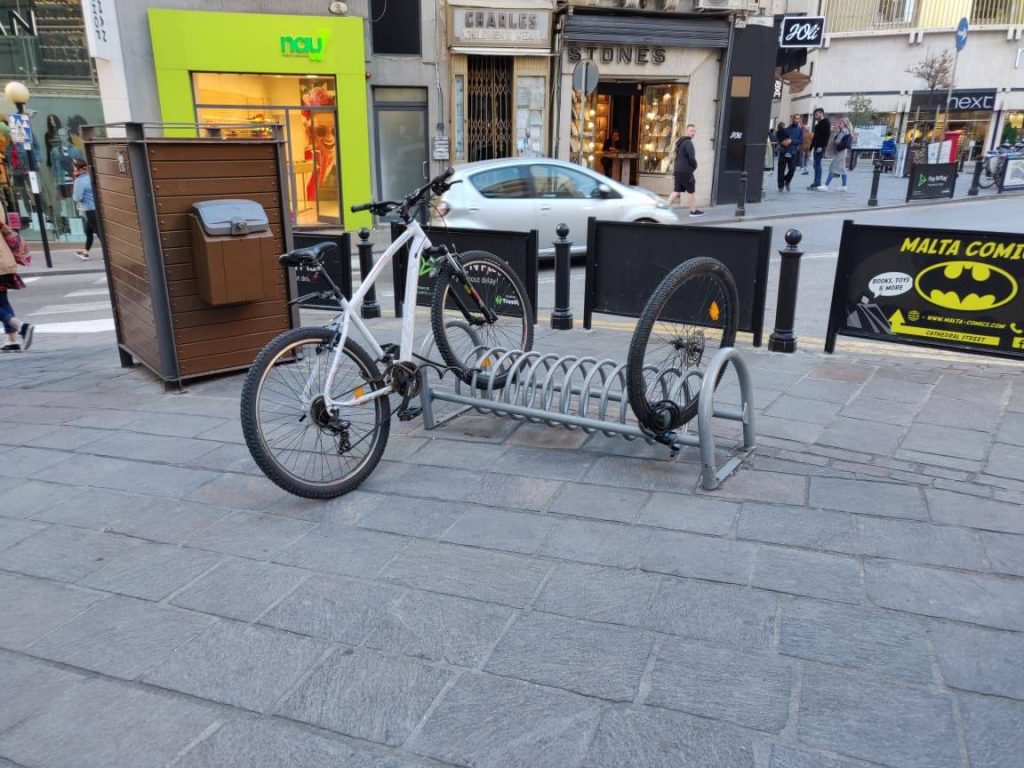
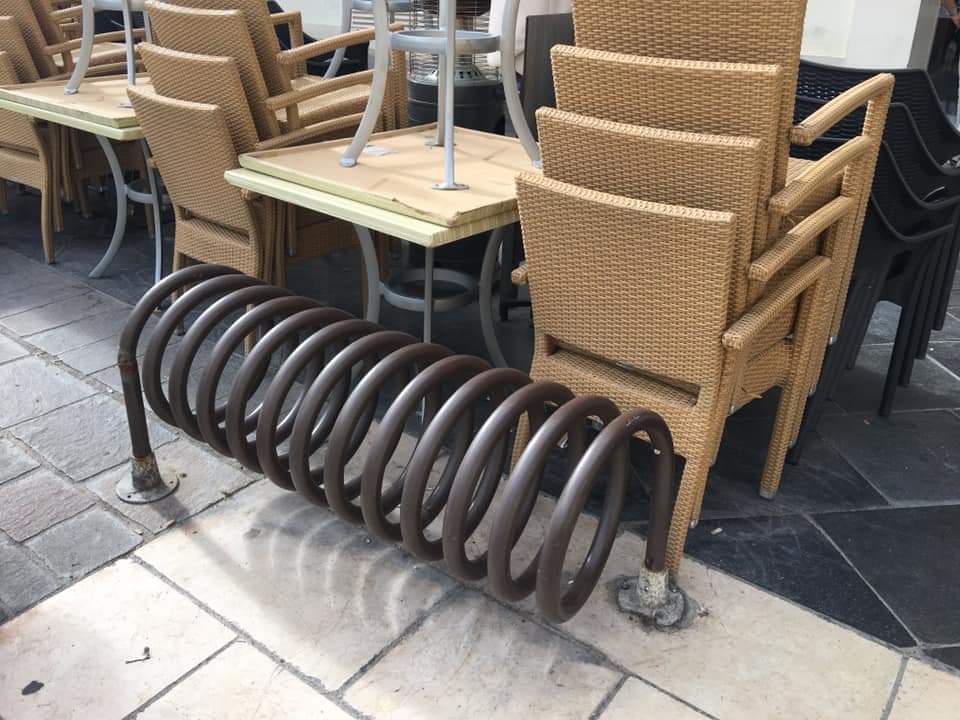
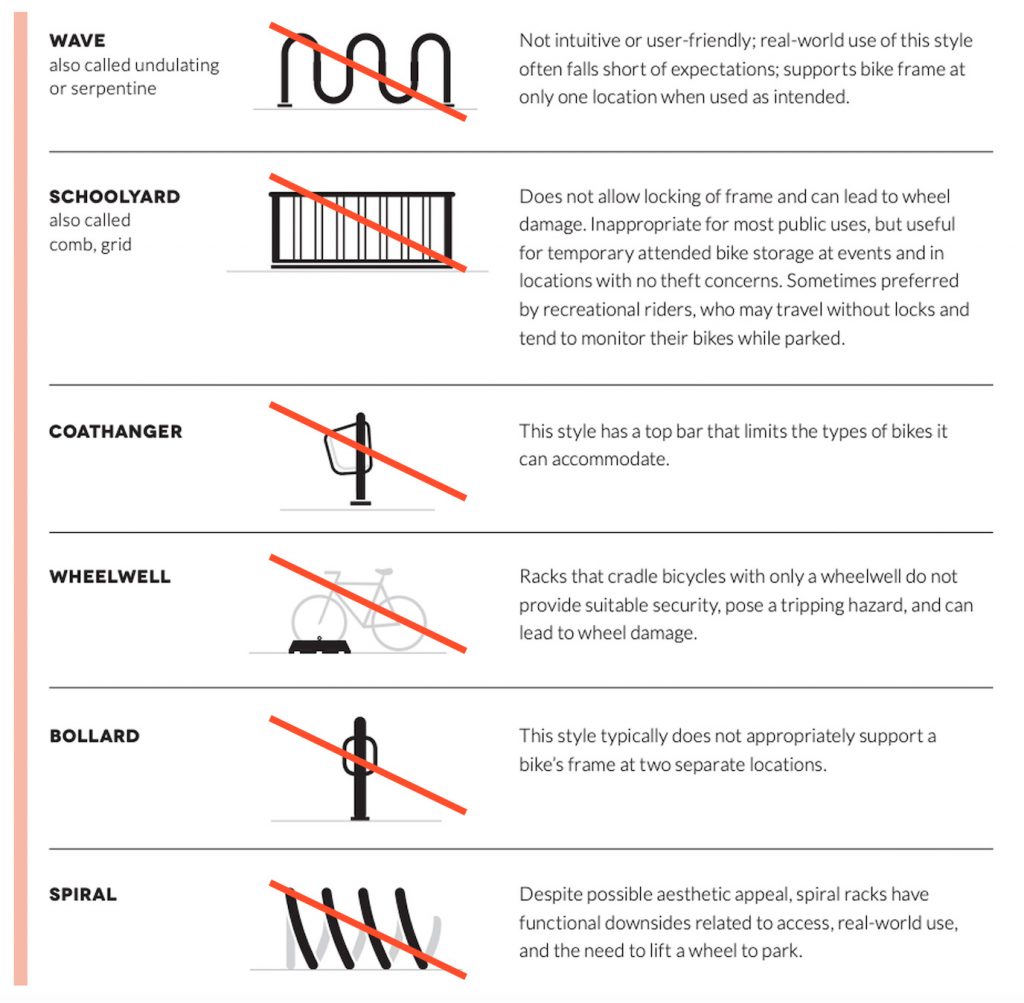
2.3 Location and layout of Bicycle Racks
The bicycle racks should be placed in safe and accessible locations. These are:
-
- In full view to maximise visibility and minimise theft or vandalism.
- Close to the main entrance / point of interest of the designated destination.
- Preferably in shade.
- Not obstructing pedestrians.
The image below illustrates our recommendation for distances between walls and the racks, between racks, and the distance between racks and the curb.
2.4 Long Term Bicycle Parking
Long term parking is underutilised in Malta, the increase of this type of parking has shown in other countries to encourage use of cycling for commuting purposes. It has also shown to reduce theft. Long-term bike parking is sheltered with added protection and enclosure, and bikes may be stored for over two hours. Long-term bike parking comes in the form of bike lockers and lockups, which includes bike shelters, bike rooms, and bike parking stations. The advantage of long-term parking is that it has a high level of protection against bike theft as it offers an enclosed space. Unauthorized access is largely eliminated, and cyclists can also leave their cycling accessories attached to their bike.
3. Estimated Costs and Government Grant
The price depends on the material, but the price ranges somewhere around €60-€300 per rack (fits 2 bicycles). Galvanised steel is cheaper (but less durable) than stainless steel bicycle racks, but the good thing is: you can get them for FREE (see below). One Sheffield type bicycle rack from local suppliers costs around €120-€150.
Local councils and non-for-profit enterprises are eligible to apply for up to 100% of the expense. Commercial enterprises are eligible to apply for up to 50% of the expenses.
3.1 How do we apply for the grant?
Links to the official Government of Malta documents and grants are linked below. The following documents are required to be eligible for the grant:
- Copy of the ID Card of the applicant or any other official document of identity (refer to Government Notice for Bicycle Racks Grants)
- Quotations for equipment purchased and works, which must specify if installation is included.
- Picture of the proposed racks
- Site plan and photos of where the bicycle racks / ancillary facilities will be installed
At reimbursement stage, the applicant must submit:
- Original Fiscal Receipts and commercial invoices. More information in the case that a fiscal receipt is not possible is found in the Government Notice for Bicycle Racks Grants linked below.
- In the case of equipment purchased from abroad, the original invoices of the purchase of such items issued by the supplier together with the delivery notes, the original documentary proof that final payment has been affected, and clearance from Maltapost/Department of Customs Malta (if needed) must be provided.
These documents need to be submitted to: Board for the Bicycle Rack Fund, Ministry for Finance and Employment, Maison Demandols, South Street, Valletta
Find below the government notice, and english and maltese versions of the grants
Government Notice for Bicycle Racks Grants
Bicycle Racks Application Form 2022
4. Bicycle Racks Suppliers
If you know of any other supplier, or if any of these suppliers do not offer the service anymore, please let us know on [email protected].
-
Steve Sciberras – Bike it up! Bicycle and repair shop – +356 99238819 – [email protected]
- Robert Camilleri | +356 99460058 | [email protected]
- General Maintenance Ltd. | +35621647068 | [email protected]
- Green Skip Group Ltd | +35621422009 | [email protected]
- Anton Zarb Cast Iron Products | +35699475172 | [email protected]
- Bondin Metal Works
- Jacap Ltd | +356 21416247
- Manwel Fenech | +99491775
For overseas purchases, you can take a look at the links below. The price from this supplier ranges from €60 – €160 per bicycle rack (each fits 2 bicycles).
- Galvanised Sheffield Stand
- Stainless Steel Sheffield Stand (Sub-Surface Mounted)
- Stainless Steel Sheffield Stand (Surface Mounted)
- Sheffield Toast Rack (10 bicycles)
For additional signage works, our members recommend Viking Signrite Ltd.
Please contact us on [email protected] if you have any additional queries.



